Centrelink System Analysis: Reviewing the System Before RoboDebt
VerifiedAdded on 2023/04/21
|7
|1808
|201
Literature Review
AI Summary
This literature review analyzes Centrelink's system and processes before the implementation of the RoboDebt algorithm, focusing on the shift in debt recovery services and the burden of proof. It references several key works to understand the foundation of Centrelink, the factors leading to overpayments and debt, and the government's rationale for adopting algorithms. The review highlights the perceived benefits and drawbacks of the new system, including concerns about incorrect debt calculations and judgments, and contrasts the pre-algorithm system's human intervention with the automated processes of RoboDebt. It explores the impact of these changes on recipients, including emotional and physical effects, and uses the cited works to compare recipient perceptions of debt before and after automation. This analysis provides a comprehensive overview of the system before RoboDebt, setting the stage for understanding the subsequent changes and their implications.
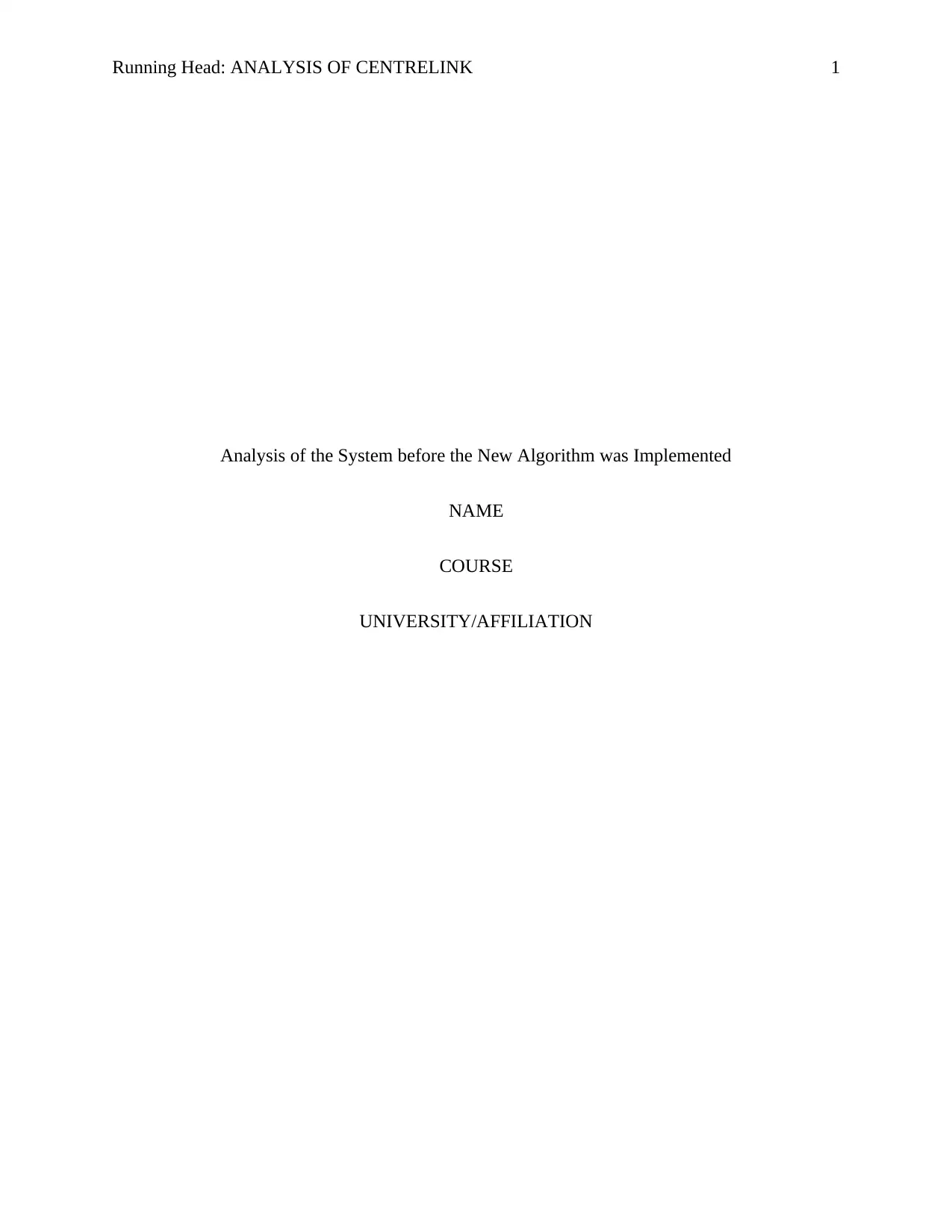
Running Head: ANALYSIS OF CENTRELINK 1
Analysis of the System before the New Algorithm was Implemented
NAME
COURSE
UNIVERSITY/AFFILIATION
Analysis of the System before the New Algorithm was Implemented
NAME
COURSE
UNIVERSITY/AFFILIATION
Paraphrase This Document
Need a fresh take? Get an instant paraphrase of this document with our AI Paraphraser

ANALYSIS OF CENTRELINK 2
Research Problem: The ATO and Centrelink have integrated algorithms that enhances
automation of activities. Following these developments, the ways in which recipients were
offered debt services have undergone several changes. Also, the Australian government
management practices have changed greatly as a result. For instance, algorithms have reduced
state responsibilities since it does not deal with issues that are raised by recipients. However, the
workload has been transferred to the recipients since it is their responsibility to ensure that they
have updated their details on regular basis. Besides, they have to make sure that their debts have
been calculated correctly. These changes have affected recipients not only limited to emotional
issues, but also physical.
1. Watts, R. (2016). “Running on Empty”: Australia’s Neoliberal Social Security System,
1988–2015. In Basic Income in Australia and New Zealand (pp. 69-91). Palgrave
Macmillan, New York.
Watts (2016) argues that in 19th century, Australians depended on benevolent societies for
financial assistance. Hence, the term social security was none existent. However, the situation
improved as a result of increased trading activities that were influenced by trade unions. In early
1900, people with disabilities together with the old age started to receive pension. Apart from
pension, maternity allowance also became evident in 1912 (Watts, 2016). Other allowances that
followed in subsequent years include widow’s pension and wife’s allowance. Watts (2016) states
that social security started in 1988. Following these developments, there was a need to manage
government services. Hence, Centrelink agency was established in 1997. Subsequently, offices
were built across the country to enable citizens to access social security services easily by using
mobile devices such as laptops (Watts, 2016). He also continues to argue that through
Centrelink the Australian government has been able to determine the total revenue as well as the
total expense. The following are some of the payment types that are offered by Centrelink;
Research Problem: The ATO and Centrelink have integrated algorithms that enhances
automation of activities. Following these developments, the ways in which recipients were
offered debt services have undergone several changes. Also, the Australian government
management practices have changed greatly as a result. For instance, algorithms have reduced
state responsibilities since it does not deal with issues that are raised by recipients. However, the
workload has been transferred to the recipients since it is their responsibility to ensure that they
have updated their details on regular basis. Besides, they have to make sure that their debts have
been calculated correctly. These changes have affected recipients not only limited to emotional
issues, but also physical.
1. Watts, R. (2016). “Running on Empty”: Australia’s Neoliberal Social Security System,
1988–2015. In Basic Income in Australia and New Zealand (pp. 69-91). Palgrave
Macmillan, New York.
Watts (2016) argues that in 19th century, Australians depended on benevolent societies for
financial assistance. Hence, the term social security was none existent. However, the situation
improved as a result of increased trading activities that were influenced by trade unions. In early
1900, people with disabilities together with the old age started to receive pension. Apart from
pension, maternity allowance also became evident in 1912 (Watts, 2016). Other allowances that
followed in subsequent years include widow’s pension and wife’s allowance. Watts (2016) states
that social security started in 1988. Following these developments, there was a need to manage
government services. Hence, Centrelink agency was established in 1997. Subsequently, offices
were built across the country to enable citizens to access social security services easily by using
mobile devices such as laptops (Watts, 2016). He also continues to argue that through
Centrelink the Australian government has been able to determine the total revenue as well as the
total expense. The following are some of the payment types that are offered by Centrelink;
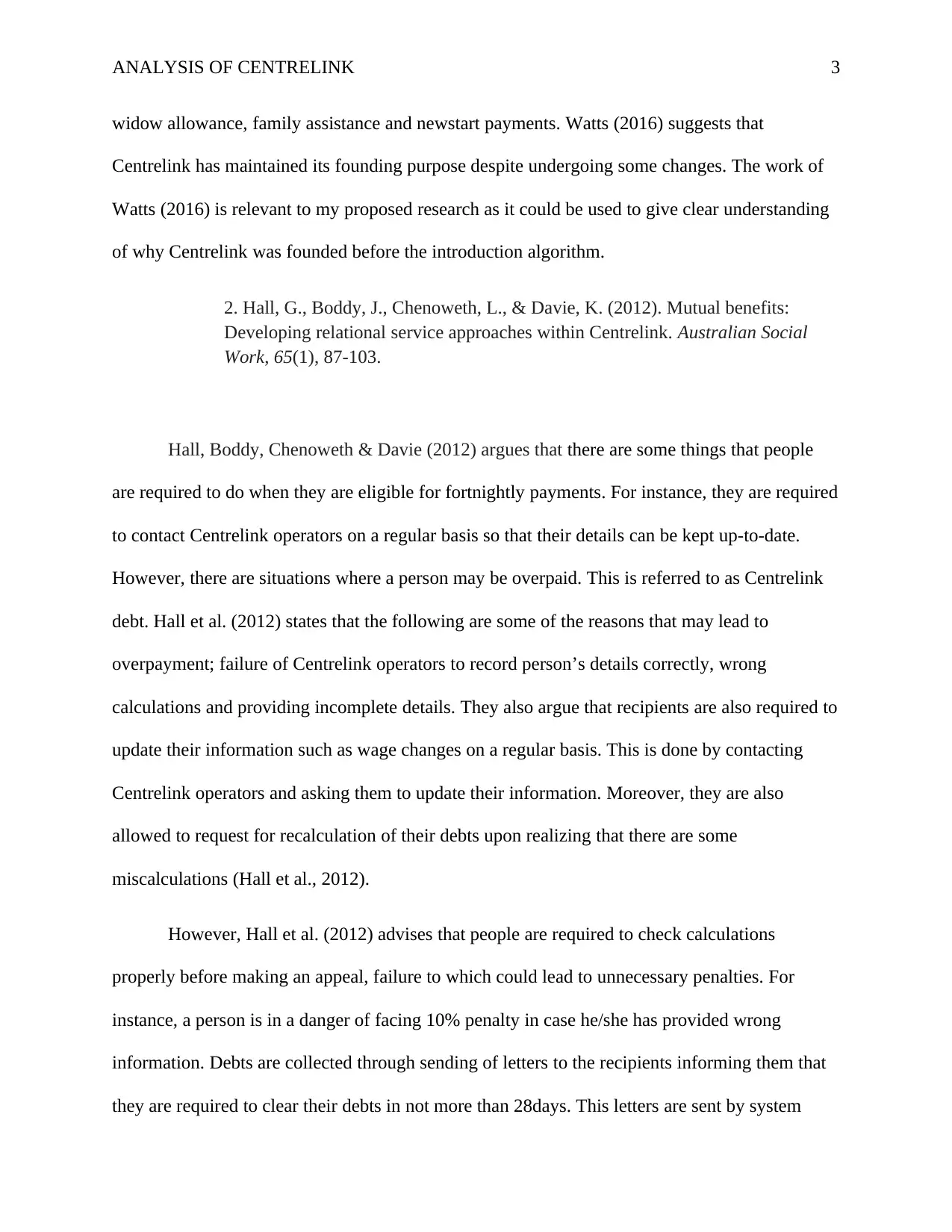
ANALYSIS OF CENTRELINK 3
widow allowance, family assistance and newstart payments. Watts (2016) suggests that
Centrelink has maintained its founding purpose despite undergoing some changes. The work of
Watts (2016) is relevant to my proposed research as it could be used to give clear understanding
of why Centrelink was founded before the introduction algorithm.
2. Hall, G., Boddy, J., Chenoweth, L., & Davie, K. (2012). Mutual benefits:
Developing relational service approaches within Centrelink. Australian Social
Work, 65(1), 87-103.
Hall, Boddy, Chenoweth & Davie (2012) argues that there are some things that people
are required to do when they are eligible for fortnightly payments. For instance, they are required
to contact Centrelink operators on a regular basis so that their details can be kept up-to-date.
However, there are situations where a person may be overpaid. This is referred to as Centrelink
debt. Hall et al. (2012) states that the following are some of the reasons that may lead to
overpayment; failure of Centrelink operators to record person’s details correctly, wrong
calculations and providing incomplete details. They also argue that recipients are also required to
update their information such as wage changes on a regular basis. This is done by contacting
Centrelink operators and asking them to update their information. Moreover, they are also
allowed to request for recalculation of their debts upon realizing that there are some
miscalculations (Hall et al., 2012).
However, Hall et al. (2012) advises that people are required to check calculations
properly before making an appeal, failure to which could lead to unnecessary penalties. For
instance, a person is in a danger of facing 10% penalty in case he/she has provided wrong
information. Debts are collected through sending of letters to the recipients informing them that
they are required to clear their debts in not more than 28days. This letters are sent by system
widow allowance, family assistance and newstart payments. Watts (2016) suggests that
Centrelink has maintained its founding purpose despite undergoing some changes. The work of
Watts (2016) is relevant to my proposed research as it could be used to give clear understanding
of why Centrelink was founded before the introduction algorithm.
2. Hall, G., Boddy, J., Chenoweth, L., & Davie, K. (2012). Mutual benefits:
Developing relational service approaches within Centrelink. Australian Social
Work, 65(1), 87-103.
Hall, Boddy, Chenoweth & Davie (2012) argues that there are some things that people
are required to do when they are eligible for fortnightly payments. For instance, they are required
to contact Centrelink operators on a regular basis so that their details can be kept up-to-date.
However, there are situations where a person may be overpaid. This is referred to as Centrelink
debt. Hall et al. (2012) states that the following are some of the reasons that may lead to
overpayment; failure of Centrelink operators to record person’s details correctly, wrong
calculations and providing incomplete details. They also argue that recipients are also required to
update their information such as wage changes on a regular basis. This is done by contacting
Centrelink operators and asking them to update their information. Moreover, they are also
allowed to request for recalculation of their debts upon realizing that there are some
miscalculations (Hall et al., 2012).
However, Hall et al. (2012) advises that people are required to check calculations
properly before making an appeal, failure to which could lead to unnecessary penalties. For
instance, a person is in a danger of facing 10% penalty in case he/she has provided wrong
information. Debts are collected through sending of letters to the recipients informing them that
they are required to clear their debts in not more than 28days. This letters are sent by system
⊘ This is a preview!⊘
Do you want full access?
Subscribe today to unlock all pages.

Trusted by 1+ million students worldwide
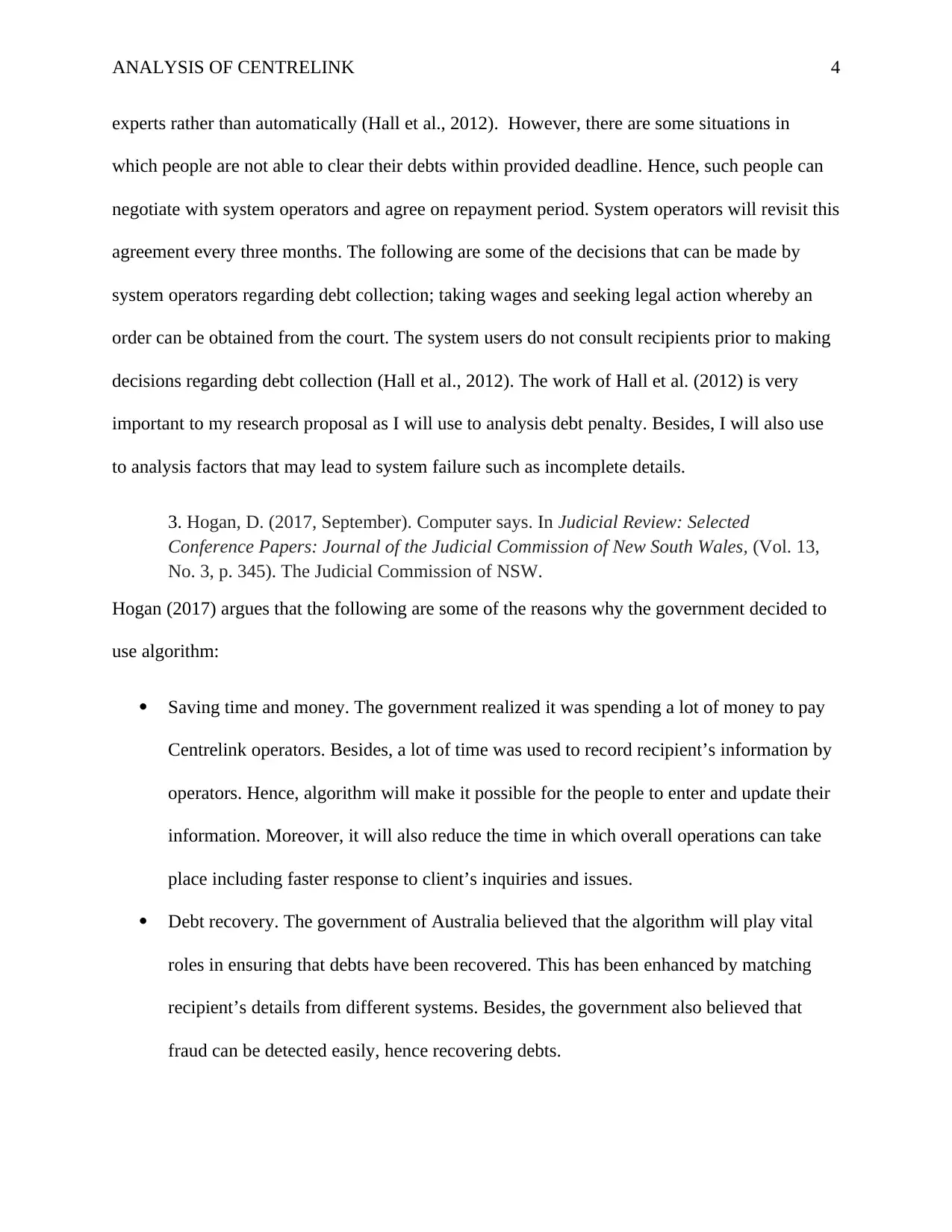
ANALYSIS OF CENTRELINK 4
experts rather than automatically (Hall et al., 2012). However, there are some situations in
which people are not able to clear their debts within provided deadline. Hence, such people can
negotiate with system operators and agree on repayment period. System operators will revisit this
agreement every three months. The following are some of the decisions that can be made by
system operators regarding debt collection; taking wages and seeking legal action whereby an
order can be obtained from the court. The system users do not consult recipients prior to making
decisions regarding debt collection (Hall et al., 2012). The work of Hall et al. (2012) is very
important to my research proposal as I will use to analysis debt penalty. Besides, I will also use
to analysis factors that may lead to system failure such as incomplete details.
3. Hogan, D. (2017, September). Computer says. In Judicial Review: Selected
Conference Papers: Journal of the Judicial Commission of New South Wales, (Vol. 13,
No. 3, p. 345). The Judicial Commission of NSW.
Hogan (2017) argues that the following are some of the reasons why the government decided to
use algorithm:
Saving time and money. The government realized it was spending a lot of money to pay
Centrelink operators. Besides, a lot of time was used to record recipient’s information by
operators. Hence, algorithm will make it possible for the people to enter and update their
information. Moreover, it will also reduce the time in which overall operations can take
place including faster response to client’s inquiries and issues.
Debt recovery. The government of Australia believed that the algorithm will play vital
roles in ensuring that debts have been recovered. This has been enhanced by matching
recipient’s details from different systems. Besides, the government also believed that
fraud can be detected easily, hence recovering debts.
experts rather than automatically (Hall et al., 2012). However, there are some situations in
which people are not able to clear their debts within provided deadline. Hence, such people can
negotiate with system operators and agree on repayment period. System operators will revisit this
agreement every three months. The following are some of the decisions that can be made by
system operators regarding debt collection; taking wages and seeking legal action whereby an
order can be obtained from the court. The system users do not consult recipients prior to making
decisions regarding debt collection (Hall et al., 2012). The work of Hall et al. (2012) is very
important to my research proposal as I will use to analysis debt penalty. Besides, I will also use
to analysis factors that may lead to system failure such as incomplete details.
3. Hogan, D. (2017, September). Computer says. In Judicial Review: Selected
Conference Papers: Journal of the Judicial Commission of New South Wales, (Vol. 13,
No. 3, p. 345). The Judicial Commission of NSW.
Hogan (2017) argues that the following are some of the reasons why the government decided to
use algorithm:
Saving time and money. The government realized it was spending a lot of money to pay
Centrelink operators. Besides, a lot of time was used to record recipient’s information by
operators. Hence, algorithm will make it possible for the people to enter and update their
information. Moreover, it will also reduce the time in which overall operations can take
place including faster response to client’s inquiries and issues.
Debt recovery. The government of Australia believed that the algorithm will play vital
roles in ensuring that debts have been recovered. This has been enhanced by matching
recipient’s details from different systems. Besides, the government also believed that
fraud can be detected easily, hence recovering debts.
Paraphrase This Document
Need a fresh take? Get an instant paraphrase of this document with our AI Paraphraser
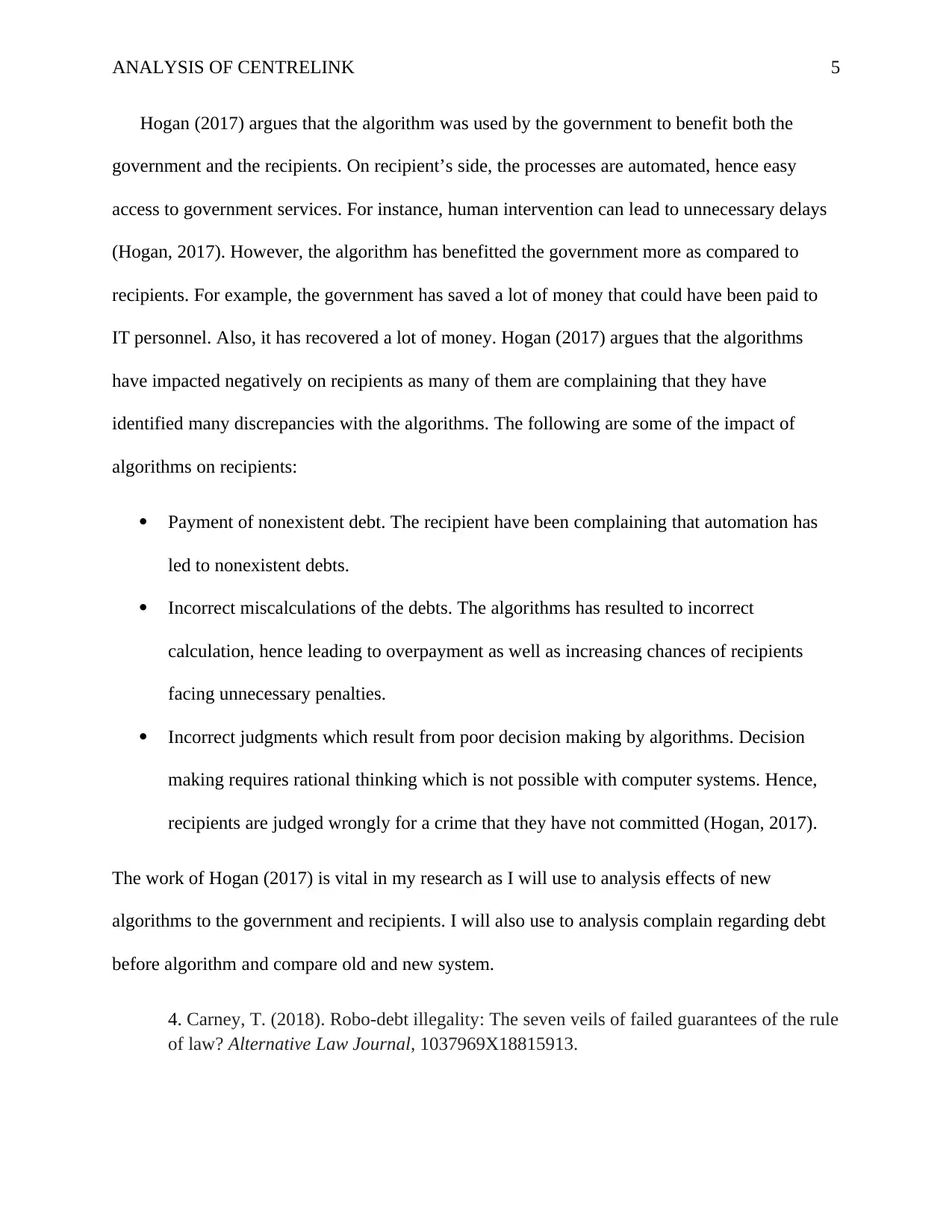
ANALYSIS OF CENTRELINK 5
Hogan (2017) argues that the algorithm was used by the government to benefit both the
government and the recipients. On recipient’s side, the processes are automated, hence easy
access to government services. For instance, human intervention can lead to unnecessary delays
(Hogan, 2017). However, the algorithm has benefitted the government more as compared to
recipients. For example, the government has saved a lot of money that could have been paid to
IT personnel. Also, it has recovered a lot of money. Hogan (2017) argues that the algorithms
have impacted negatively on recipients as many of them are complaining that they have
identified many discrepancies with the algorithms. The following are some of the impact of
algorithms on recipients:
Payment of nonexistent debt. The recipient have been complaining that automation has
led to nonexistent debts.
Incorrect miscalculations of the debts. The algorithms has resulted to incorrect
calculation, hence leading to overpayment as well as increasing chances of recipients
facing unnecessary penalties.
Incorrect judgments which result from poor decision making by algorithms. Decision
making requires rational thinking which is not possible with computer systems. Hence,
recipients are judged wrongly for a crime that they have not committed (Hogan, 2017).
The work of Hogan (2017) is vital in my research as I will use to analysis effects of new
algorithms to the government and recipients. I will also use to analysis complain regarding debt
before algorithm and compare old and new system.
4. Carney, T. (2018). Robo-debt illegality: The seven veils of failed guarantees of the rule
of law? Alternative Law Journal, 1037969X18815913.
Hogan (2017) argues that the algorithm was used by the government to benefit both the
government and the recipients. On recipient’s side, the processes are automated, hence easy
access to government services. For instance, human intervention can lead to unnecessary delays
(Hogan, 2017). However, the algorithm has benefitted the government more as compared to
recipients. For example, the government has saved a lot of money that could have been paid to
IT personnel. Also, it has recovered a lot of money. Hogan (2017) argues that the algorithms
have impacted negatively on recipients as many of them are complaining that they have
identified many discrepancies with the algorithms. The following are some of the impact of
algorithms on recipients:
Payment of nonexistent debt. The recipient have been complaining that automation has
led to nonexistent debts.
Incorrect miscalculations of the debts. The algorithms has resulted to incorrect
calculation, hence leading to overpayment as well as increasing chances of recipients
facing unnecessary penalties.
Incorrect judgments which result from poor decision making by algorithms. Decision
making requires rational thinking which is not possible with computer systems. Hence,
recipients are judged wrongly for a crime that they have not committed (Hogan, 2017).
The work of Hogan (2017) is vital in my research as I will use to analysis effects of new
algorithms to the government and recipients. I will also use to analysis complain regarding debt
before algorithm and compare old and new system.
4. Carney, T. (2018). Robo-debt illegality: The seven veils of failed guarantees of the rule
of law? Alternative Law Journal, 1037969X18815913.
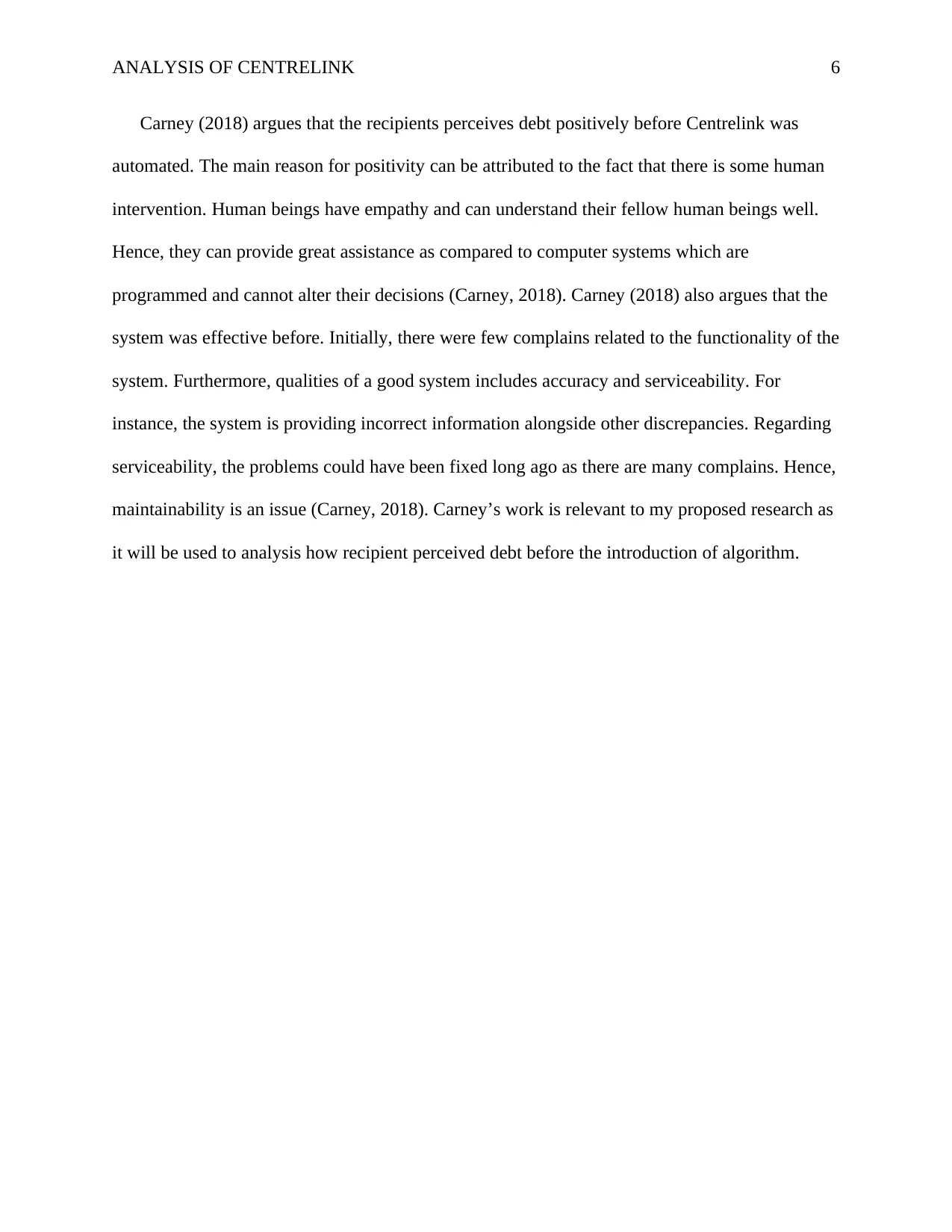
ANALYSIS OF CENTRELINK 6
Carney (2018) argues that the recipients perceives debt positively before Centrelink was
automated. The main reason for positivity can be attributed to the fact that there is some human
intervention. Human beings have empathy and can understand their fellow human beings well.
Hence, they can provide great assistance as compared to computer systems which are
programmed and cannot alter their decisions (Carney, 2018). Carney (2018) also argues that the
system was effective before. Initially, there were few complains related to the functionality of the
system. Furthermore, qualities of a good system includes accuracy and serviceability. For
instance, the system is providing incorrect information alongside other discrepancies. Regarding
serviceability, the problems could have been fixed long ago as there are many complains. Hence,
maintainability is an issue (Carney, 2018). Carney’s work is relevant to my proposed research as
it will be used to analysis how recipient perceived debt before the introduction of algorithm.
Carney (2018) argues that the recipients perceives debt positively before Centrelink was
automated. The main reason for positivity can be attributed to the fact that there is some human
intervention. Human beings have empathy and can understand their fellow human beings well.
Hence, they can provide great assistance as compared to computer systems which are
programmed and cannot alter their decisions (Carney, 2018). Carney (2018) also argues that the
system was effective before. Initially, there were few complains related to the functionality of the
system. Furthermore, qualities of a good system includes accuracy and serviceability. For
instance, the system is providing incorrect information alongside other discrepancies. Regarding
serviceability, the problems could have been fixed long ago as there are many complains. Hence,
maintainability is an issue (Carney, 2018). Carney’s work is relevant to my proposed research as
it will be used to analysis how recipient perceived debt before the introduction of algorithm.
⊘ This is a preview!⊘
Do you want full access?
Subscribe today to unlock all pages.

Trusted by 1+ million students worldwide

ANALYSIS OF CENTRELINK 7
References
Carney, T. (2018). Robo-debt illegality: The seven veils of failed guarantees of the rule of
law? Alternative Law Journal, 1037969X18815913.
Hall, G., Boddy, J., Chenoweth, L., & Davie, K. (2012). Mutual benefits: Developing relational
service approaches within Centrelink. Australian Social Work, 65(1), 87-103.
Hogan, D. (2017, September). Computer says. In Judicial Review: Selected Conference Papers:
Journal of the Judicial Commission of New South Wales, (Vol. 13, No. 3, p. 345). The
Judicial Commission of NSW.
Watts, R. (2016). “Running on Empty”: Australia’s Neoliberal Social Security System, 1988–
2015. In Basic Income in Australia and New Zealand (pp. 69-91). Palgrave Macmillan,
New York.
References
Carney, T. (2018). Robo-debt illegality: The seven veils of failed guarantees of the rule of
law? Alternative Law Journal, 1037969X18815913.
Hall, G., Boddy, J., Chenoweth, L., & Davie, K. (2012). Mutual benefits: Developing relational
service approaches within Centrelink. Australian Social Work, 65(1), 87-103.
Hogan, D. (2017, September). Computer says. In Judicial Review: Selected Conference Papers:
Journal of the Judicial Commission of New South Wales, (Vol. 13, No. 3, p. 345). The
Judicial Commission of NSW.
Watts, R. (2016). “Running on Empty”: Australia’s Neoliberal Social Security System, 1988–
2015. In Basic Income in Australia and New Zealand (pp. 69-91). Palgrave Macmillan,
New York.
1 out of 7
Your All-in-One AI-Powered Toolkit for Academic Success.
+13062052269
info@desklib.com
Available 24*7 on WhatsApp / Email
![[object Object]](/_next/static/media/star-bottom.7253800d.svg)
Unlock your academic potential
Copyright © 2020–2025 A2Z Services. All Rights Reserved. Developed and managed by ZUCOL.